Our trip to the ancient kingdom of Ethiopia was at once fascinating, superbly bird-rich, as promised and, at times, confronting and challenging. Thanks, however, to the adventurous spirit and enquiring minds of our wonderful group we explored parts of Ethiopia rarely if ever witnessed by birders and naturalists. Ethiopia is an endlessly intriguing and, at times, a very exciting natural history destination that coupled with its fabled and dramatic history, a remarkable landscape and some truly charming people presented us with an unforgettable experience.
Ethiopia is an astonishingly, beautiful country quite unlike anywhere else in Africa and likely the most extraordinary country you will ever visit on the continent. David Bishop Bird Tours designed a very special tour that permitted us to discover that Ethiopia is a culturally, scenically, and historically fantastic destination in addition to being a storehouse of natural history wonders. Once synonymous with famine and desert, Ethiopia, is dominated by a lush, fertile highland plateau that dominates the country and is as far removed from this misleadingly negative image as it is possible to be.Ethiopia often referred to as ‘the roof of Africa’ is an ancient land that boasts some of Africa’s highest mountains surmounted by lush, wildlife-rich highland forests, vast agricultural uplands, the epic rift valley with its tremendous lakes teeming with birds, and vast savannas. It also encompasses some very interesting semi-arid country in the south. We timed this tour when large numbers of Palearctic migrants would present in addition to a fabulous coterie of endemics and near endemics (the second largest total for any African country) together with a host of very visible species. Ethiopia is wonderfully birdy and supports at least 850 species of birds including such mega-charismatic and glamorous species as Prince Ruspoli’s Turaco, Rouget’s Rail and the peculiar Stresemann’s Bush-crow. In addition Ethiopia hosts an impressive list of mammals, including remarkable endemics such as Gelada Baboon, Mountain Nyala and Ethiopian Wolf. We made a special effort to locate all of the endemics as well as a good list of mammals and encountered 470+ species of birds and 40+ species of mammals without turning the tour into a grind. Thanks to a culture that does not hunt or harry wildlife, much of what we saw, as evidenced by the images including in this report (all of which were taken during this tour) were very confiding and offered photographers a bevy of exciting opportunities.
As I wrote after our Tanzania odysee ‘I love Africa dearly’. That holds even truer today as I reflect upon our recent trip to Ethiopia. Undoubtedly there were some ‘interesting moments’ along the way. I am absolutely sure we could have all done without the horrible food poisoning we all succumbed to at some point in the trip. I certainly could have – throwing up in front of the immigration officer on my departure was not my finest moment. But as a client once said “It goes with travel”. Indeed it does and I for one would not have missed this extraordinary experience for anything. The timing of our trip was near perfect in that we encountered virtually no rain (in some cases this may have actually been a disadvantage). We saw some incredible creatures including virtually all of the endemics, near-endemics and specialty birds – please recall – nesting Scissor-tailed Kite; displaying Kori Bustard; the lovely Prince Ruspoli’s Turaco; not one but two sightings of the enigmatic Egyptian Plover; the peculiar Thick-billed Raven and even more bizarre Stresemann’s Bush-Crow, together with some truly outstanding mammals – think Ethiopian Wolf, Mountain Nyala, Gelada Baboon, Caracal and the peculiar Giant Root Rat. The accommodations were generally much better than anticipated; some such as the Etho-Omo Lodge were a delight, especially their delicious Italian food, whilst others such as the Fawlty Towers–esque hotel at Yabello and Gobe were memorably awful and exactly the sort of places that make for great telling back home. As always we had some good stories and great laughs. Our drivers were exceptional – professional, caring and superb birders into the bargain. Similarly the two four-wheel-drive vehicles were just the job and I cannot imagine in my wildest nightmares considering driving in Ethiopia in anything less. Our ground-agents are to be congratulated on their foresight. Ashenafi was a memorable guide for us throughout our time in the Omo Region and I personally extend to him my deepest thanks. But my most heartfelt thanks are to Kaaren and Stephanie, Karen and Chris for as always being such delightfully interesting, caring, loving and fun people to travel with.
Thank you one and all.
The Story
17 February
Everyone arrives safe and sound and settles into the Ghion Hotel deep in the heart of the capital Addis Ababa.
18th February
A fascinating day in the hands of Ashenafi, exploring the museums and antiquities of the capital. The national museum with the remarkably important fossil skull of Lucy – so named because the Beetles’ song ‘Lucy in the sky with diamonds’ was playing in the background at the time of the discovery. Surreal!
19th February
Our first birding outing in Ethiopia. Driving through Addis was an experience in itself but seemingly easily negotiated thanks to our superb drivers who were very adept at moving along whilst at the same time avoiding donkeys and carts, pedestrians who lacked any road-sense whatsoever; the inevitable beggars; bullish buses and overladen trucks belching out the most toxic plumes of charcoal smoke whilst massive potholes appeared in the middle of a road. Amazing! Our first stop was a grubby little stream on the edge o
f town surrounded by a copse of introduced Eucalypt trees. Birds here included: 7 African Black Ducks, several Hadada, 3 Wire-tailed Swallows, 2 Mountain Wagtails and our first Brown-rumped Seedeaters. Continuing south down the Rift Valley we wended our way to the Debra Lake and Lake Cheleleka. The latter is a broad, ephemeral pan unlike all the others, which are steep volcanic waterbodies. As it happened Lake Cheleleka was relatively dry with masses of birds crowding into the last remaining area of open water. Hundreds, possibly as many 600 Common Cranes and 800 Marabous crowded together to produce quite a spectacle. It was also a good opportunity to study Palearctic shorebirds which here included: Black-tailed Godwit, Ruff, Curlew Sandpiper, Temminck’s and Little stints, Common Snipe, Common Sandpiper, Common Greenshank and Wood Sandpiper. Other highlights of this birdy morning included: several soaring Tawny eagles, a Booted Eagle, and numerous Red-throated Pipits including several in pretty nice plumage. Surprisingly there were virtually no ducks. Arriving back at the Ghion in time for lunch we used the afternoon to explore its bird-rich gardens.In spite of the huge numbers of wedding celebrants we found a good number of species including our sole White-backed Black Tit of the trip.
20th February
Our safari began in earnest this morning as we departed Addis and climbed up over the Entoto Mountains to the Salulta Plains. Before continuing on and despite the traffic we were able to admire the spectacular views of Addis that the road affords. The Salulta Plains, albeit heavily populated nevertheless comprises a fascinating mosaic of traditional pasture, hay meadows and grain fields in addition to many small tarns and marshes which attract a variety of waterbirds plus a fine selection of open country species.
This morning with a warm sun and bright blue sky provided a great morning’s birding, highlights including: a flock of 43 of the increasingly very localised Spot-breasted Lapwing; lovely but elusive Abyssinian Longclaw; Blue-winged Goose; endemic Wattled Ibis; Black-winged Lapwing; a loan Black Stork; numerous White-collared Pigeons and Erlanger’s Lark. This high altitude country is host to small ‘tukul’ villages characterised by the thatched-roofed, earthen-walled houses that are so typical of Ethiopia and here dot the landscape whilst robed horsemen ride across the plains to tend their livestock. We also made what was to be the first of many fine coffee stops throughout the trip. The views as we approached the Etho-German Park Lodge and our home for two nights was nothing short of spectacular – set high on the lip of the escarpment overlooking the Jemma Valley it is possible to see for miles and miles, with raptors soaring at head-height providing wonderful photographic opportunities.
After settling into our attractive rooms we enjoyed a traditional luncheon in between dashing out to see the likes of Hemprich’s Hornbill. A welcome nap followed before we ventured out along a narrow trail to the Portuguese Bridge built by Ras Darge just over 100 years ago. Birds of note this afternoon included: close soaring Lammergeier, Ruppell’s Vultures both soaring and at the nest; Blue-breasted Bee-eaters; a single migrating Peregrine Falcon; Ethiopian Boubou; acrobatic Fan-tailed Ravens; Red-rumped Swallows; superb close encounters with White-rumped Babblers; the endemic albeit rather demure Abyssinian Slaty Flycatcher; several Ruppell’s Chats; both Mocking and White-winged cliff chats providing a very necessary comparison; and White-billed and Slender-billed starlings.
21st February
Departing at 05.00 in the freezing cold we wound our way down the precipitous escarpment of the enormous Jemma Valley to a well known pass for the very localized Harwood’s Francolin. Drinking coffee, munching breakfast and waiting for the first rays of sun to warm us and the birds it, was fascinating to be immersed in this other world of cloaked people quietly going about their daily chores whilst bemused by the appearance of a group of optic wielding foreigners. After a bit of ‘faffing’ around we finally latched onto as many as five Erckel’s and four Harwood’s francolins — thank heavens!
Descending once more we followed the dusty, dirt track further into maw of this enormous valley, stopping for a group of prehistoric-looking ground-hornbills before crossing the Jemma River. One cannot help but sense being in a very wild, remote place as you descend from 2600m on the plateau down to 1300m at the river which is remarkable given that we were only a few hours from the sprawling capital, Addis. Overall it was very dry and dusty and heavily cultivated with patches of brush and small trees along drainage lines. Eventually we pulled over at a small bridge alongside a deep-sided stream, which supported relatively lush vegetation including gnarled fig trees clinging to the rock walls. Whilst Merid prepared breakfast we birded the area finding a flock of circa 20 lovely Crimson-rumped Waxbills feeding on seeds of tall grasses along the stream.
Sadly Karen was miserably sick so we decided to head back to our lodge stopping along the way for superb views of Fox Kestrel and a very obliging male Abyssinian Wheatear. Happily Karen was beginning to show signs of recovery by the time we were back on the Salulta Plains, which was especially fortunate as near Muka Turi we found a big flock of vultures and other scavengers feeding on the remnants of a horse. However, best of all, a little further north was a huge troop of the spectacular Gelada Baboon. Watching these spectacular primates, especially the alpha male with his striking deep pink-red chest and imposing canines was an undoubted highlight of the entire tour. Thereafter we spent a very enjoyable afternoon birding the grounds of the Etho-German Park Lodge in particular watching raptors rising up from the valley below to soar just over our heads. Highlights included: Egyptian and Ruppell’s vultures, Augur Buzzard, and a lovely male and female Montague’s Harrier.
22nd February
After breakfast and some early morning birding around the Etho-German Park lodge we headed across the Salulta Plains to the lip of the Jemma Valley escarpment. At the ‘T’ junction we headed east still atop the Salulta Plains. We stopped at several small streams and ‘tarns’ which provided good birding despite being in the midst of seemingly massively overgrazed grasslands. Some of the birds and mammals that we encountered included: Our first Rouget’s Rail, skulking in a tiny remnant piece of scrub. What a moment! Turrah! I so love crakes and rails.
An Ortolan Bunting was a nice surprise; 8 Yellow Bishop Birds, wearing sufficient breeding plumage as to be comfortably identifiable; a dapper Three-banded Plover; Greenshank, Wood and Green sandpipers and Temminck’s Stint, several Chiffchaffs, Thekla Larks and somber Moorchats; more of the endemic Blue-winged Geese and the enchanting and endemic Harrington’s Rat. Whenever we stopped there were often people around who appeared genuinely intrigued by our antics BUT never did we encounter any problems or hassle whatsoever. In fact quite the contrary to what we had been led to believe would be the case. In fact many of the people we met were especially friendly and charming and rarely if ever were a bother.
We drove on to the large township of Debra Birhan via the village of Mendida. Much to our astonishment a brand new hotel awaited us. In fact so new there were several ‘interesting’ sections still unfinished. Nevertheless it was substantially more comfortable than we had anticipated and the dining room service by a young lady from Kenya put a smile on all our faces. We had been brought to Debra Birhan in order to try and see the famous Ankober Serin. My ex-father-in-law John Ash first discovered this unprepossessing little bird near the township of Ankober on 19th December 1976. Knowing that the areas where the serin could easily be and are typically immersed in cold, damp fog I was heartily relieved to arrive in lovely warm sunshine and deep blue skies.
Ascending through rolling, open farmland we made the 46 km drive north from Debra Birhan and the ascent to nearly 3,400m in barely an hour. Literally had we stepped from our 4WDs than we found a group of eight Ankober Serins feeding right at our feet. How lucky were we. With relatively little else to see we spent an hour so enjoying the truly, truly spectacular vertiginous cliffs from which we peered down to the Rift Valley below. A family of hyraxes watched as nonchalantly from a sunny patch on the cliff edge whilst a magnificent dark-morph Augur Buzzard sailed over David’s head as clambered to the top of the nearest peak.
23rd February
As was the Jemma Valley the descent below the Ankober escarpment was a world away from the mist-enveloped alpine moorlands of the Ethiopian Highlands. Descending a notably steep dirt road we eventually arrived at a narrow sidetrack located above a babbling brook within a mosaic of fields, thorn-scrub and degraded Acacia woodland. We had come to this site if for no other reason than to search for the endemic Yellow-throated Seedeater and this we did, handily, including close views of one very yellow-throated individual. But it was the camel caravan that will remain in our memories for a long time to come.
String after string of camels laden with firewood and heavy sacks of grain together with families, but mostly men, along with the occasional donkey appeared over the horizon, wound their way down and across the stream, up past our temporary camp and up the mountain to, as we were to later discover, a fabulous market in the village of Aliyu Amber. Dodging the camels and their leavings we birded the very birdy track down to a lookout just above the stream before dragging ourselves back for one of David’s infamous omelettes. It really was too bad that it became so hot so quickly as this was a superbly birdy site: dark-morph Booted Eagle, a loan Black Stork, Hemprich’s Hornbill, lovely Little Bee-eaters, Greater Blue-eared Starling, 3 Rufous-crowned Sparrow-Weavers were a nice find and a couple of Crimson-rumped Waxbills were a nice catch-up for Karen.
As the heat really began to impinge on us we slowly returned uphill, stopping at the Aliyu Amber market, which was strewn out across the road. Thus we sat in our air-condition 4WDs watching the goings-on of another age as people bartered for camels and goods and all the while Baglafecht Weavers, in spiffy breeding plumage, attended their nests in a fig tree overhanging the melee. Amazing stuff! Returning to Debra Birhan we packed up, enjoyed a good lunch and headed down the very comfortable tarmac road back to Addis.
24th February
With a good breakfast under our belt (it seems this is something the Ghion does quite well ….. ) we saddled up and headed down into the Rift Valley stopping for coffee at a lovely café replete with wooded grounds and a nice collection of birds: Bruce’s Green Pigeon, a nesting pair of African Paradise-flycatchers, several Wattled Starlings in rather mundane non-breeding plumage; African Thrush and Vitelline Masked Weaver. Battling the constant stream of trucks, trucks, trucks, buses, goats, camels, people and donkeys we headed southwards passing Koka lake which sadly was almost bone-dry before pulling into very the lovely Lake Ziway Hotel.
Despite the midday heat the place was alive with birds including pelicans and storks soaring low overhead as we headed to a welcome luncheon. It was pretty chaotic trying to eat whilst watching the myriad of spectacular birds that gathered in the giant dead tree that towered over our heads: Red-fronted Tinkerbird, a pair of Double-toothed Barbets attending their nest; Ruppell’s Starling, a spectacular male Scarlet-chested Sunbird and Little Weaver. Luncheon over we headed out along an ideally located berm towards the lake, which placed us in the midst of a wonderland of birds. A mosaic of two meter tall Typha Bulrush and scrub surrounded a horse-grazed wet meadow and muddy wetland and was full of birds, Huge flocks of migrant Ruff wheeled back and forth before settling with a nice collection of other shorebirds including the dainty Kittlitz’s Plover. Undoubtedly the highlight of the afternoon was the superb ‘scope views we enjoyed of the tiny and rarely seen Lesser Jacana – fabulous! Other birds included” Comb Duck, Egyptian Geese including a pair with fluffy young; Spur-winged Geese, hundreds of Marabou Storks, a solitary Long-tailed Cormorant, African Darter, Great White Pelicans, a great collection of long-legged wading birds including a Black Heron; Squacco Heron, three species of Ibis plus a very handsome African Spoonbill; African Harrier-Hawk, the magnificent African Fish-Eagle, elegant Pied Avocets, Marsh Sandpiper, Collared Pratincole, White-winged Terns, Pied and Malachite kingfishers, four glorious Northern Carmine Bee-eaters, a single Eurasian Turtle-Dove, a solitary Red-billed Oxpecker, a superb Black-headed race of Yellow Wagtail and Reichenow’s Seedeater to mention but a few.
Reluctantly taking our leave of this paradise we headed down a dusty dirt track to the southeast corner of Lake Langano to yet another paradise. A wonderful surprise laid in store for here us in the form of the very attractive and nicely appointed Hara Lodge located imaginatively on the shores of Lake Langano and surrounded by well-developed Acacia woodland. Surely there is nothing better supping a beer whilst listening to nightjars and colobus monkeys in the comfort of an easy chair overlooking a lovely lake at sunset. Hmmmm. And there was lovely dinner to boot!
25th February
Hara Lodge and Lake Langono. There is nothing quite like waking up before dawn in the African bush. The sounds of Hippos grunting in the shallows, Colobus growling amidst the high-pitched calls of hornbills as we sat down to a delicious was the perfect start to the day. And it got even better … We quickly discovered that this southeast corner of Lake Langano with well protected woodlands protected within the grounds of Hara Lodge whilst surrounded by degraded by amazingly bird-rich Acacia woodlands provided a seemingly endless list of fabulous birds. I think the highlight for me was the nesting pair of Red-throated Wrynecks. During the afternoon we explored the gloriously shady and well developed tall, moist woodland that is a feature of this corner of the lake. Here we treated ourselves to fine views of Narina’s Trogon and good numbers and close views of the endemic Yellow-headed Parrot. A seemingly rather half-hearted night walk quickly turned around with views of a Caracal; a cat KDB had only ever seen once before in 40 years!
26th February
Well the plan was that we should head off this morning to Wondo Genet for the night, however, with two of the group dreadfully sick we decided to stay at Hara Lodge for an extra night and cancel Wondo Genet. There really could not have been a better place at which to stay and recover. Thus those still standing spent the day making further exploration of the surrounding woodlands, farmland and grounds of Hara Lodge all of which continued to produce great birds not least of which was a very confiding African Pygmy Kingfisher.
27th February
With everyone slowly recovering we were fit to travel and reluctantly taking our leave of the very lovely Hara Lodge we headed out along the ‘orribly dusty road, through some very degraded woodlands back to the paved, main Rift Valley road. Turning south we joined the convoy of trucks, busses, crowds of people, camels, and donkeys heading southwards to the township of Shashemene. Turning east off the Great Rift Valley Road we drove through a long stretch farmlands that kindly provided fine views of ground-hornbills. As we started to ascend in to the southern highlands the landscape became increasingly impressive providing views over the plateau for as far as the eye could see and stockyards formed by dense thickets of Euphorbias. We stopped at the memorably forgettable Bale Mountains Hotel (2,500m) for coffee but more importantly our first Thick-billed Ravens – truly amazing birds.
Returning to our 4WDs we continued on, steadily climbing stopping for several new birds: a huge flock of Nyanza Swifts made David happy – he loves swifts; one of our very few Red-breasted Wheatears recorded on the trip and fine views of a male African Stonechat. We arrived at the Dinsho (3,200m), the headquarters of the Bale Mountains National Park in time for a good Ethiopian lunch. Led by a ranger whose name I omitted to write down we followed a narrow trail up into the magnificent Juniper forest. An equally imposing male Mountain Nyala just sat and watched us somnolently as we took as many images as we wished. Truly a special beast. The same could not be said of the quick views we had of an Ethiopian Cisticola. Climbing upwards into increasingly ancient, gnarled, old growth forest our almost equally ancient guide led us unerringly to a densely vegetated Juniper tree wherein, after much craning of the necks, we were able to ‘scope an Abyssinian Long-eared owl peering down at us. Wandering these magical woodland adorned with huge moss-cushions and draped with filigree moss we encountered more Nyala, a sounder of Warthogs and several Ethiopian Highland Bushbuck leaving us all a wonder.
Our final hurrah was a pair of infrequently seen African Wood Owls, again courtesy of our remarkable guide. Such a nice man. Heading out once again in our trusty 4WDS we drove through the village of Robe to Goba and our base for exploring the Bale Mountains. It wasn’t the worst hotel, we saved that ’accolade’ for Yabello. However, the Goba Wabe Shabelle Hotel was a caricature of government hotels throughout Africa. The food was really quite awful and despite everyone’s best efforts the service was barely passable. I still recall with amusement the fun everyone enjoyed at my expense for daring to want toast as well as an egg for breakfast. Hah!
28th February
This was a very special day and one I’m sure we had all looked forward to with keen anticipation. With everyone pretty well recovered from whatever lurgy had assailed us, we rugged up and headed up on to Sanetti Plateau. After passing through yet another massive Eucalypt plantation we began to climb more steeply through patches of indigenous Juniper forest and increasingly spectacular views of vertiginous escarpments. Screeching to a halt we imbibed the first of many oh so wonderful Rouget’s Rails which abused us from the roadside. Now that’s a Rail!!!! Climbing a little higher we left the woodland and found ourselves in a very attractive mosaic of lichen and moss covered, well-rounded rocks amidst a vast area of dense Erica moorland. Chestnut-naped Francolins were everywhere and then as we rounded a bend we were astonished to find ourselves face to face with a huge Cape Eagle Owl. Perched up in full daylight and looking very photogenic it provided us all with THE most amazing views. What a morning! Abyssinian Thrushes and Black-headed Siskins sat and sang from favoured perches as we segued onto the fabled Afro-Alpine moorlands of the Sanetii Plateau. Stark, austere and vast with slopes rising in the distance to Ethiopia’s second highest mountain and graced by strange giant plants this was exactly as we might have imagined the home of the Ethiopian Wolf.
Fortunately we didn’t have long to wait and there he was, a superbly sleek, tawny male trotting along, hunting for a choice morsel among the rodent riches that characterize the plateau. In fact we were to enjoy some exceptional views of the peculiar Giant Root-Rat one of the Wolf’s preferred prey items in addition to large numbers of the endearing Blick’s Grass Rat. Not surprisingly there were not a lot of birds or for that matter mammals, although there always seemed to be a few rodents in sight, however, we continued to add to our list with our first Ruddy Shelduck, Red-billed Chough and a nice collection of waterbirds and shorebirds. Two Lesser Spotted Eagles were an undoubted highlight as we found a suitable place to stop for lunch and time to dwell on our four Ethiopian Wolves and this fascinating biome. Descending to a mosaic of farmland and Juniper forest we spent a very productive and most enjoyable few hours here, highlights of which included: our best views of Abyssinian Catbird, a very obliging Cinnamon Bracken-Warbler, several Brown Parisomas of the Bale Mountains race, and perhaps best of all super ‘scope views of the quite elusive and uncommon Abyssinian Woodpecker. We eventually returned to Goba to once again endure the culinary delights of our hotel.
1st March
Departing exceptionally early (04.30) we headed east and downhill along a fast dirt road to Sof Omar. Along the way KDB managed to spot a male Serval along with brief glimpses of various owls, nightjars and hyaenas and then we lost our way and added an hour to our journey. Frustratingly the area we found ourselves in was full of birds but apparently we had to press on. I would so have loved to returned to that site once again at dawn. Oh well. Eventually we pulled into the tiny, dusty, dry valley that guards the entrance to the revered caves that were once the home of a Muslim cleric Sof Omar. As breakfast was cooking we birded quickly as they day was already heating up. Again I wished we had more time here as it seemed a fascinating place. Some of the morning’s highlights included: 2 Salvadori’s Seedeaters – primus inter pares a very localized endemic and we enjoyed exceptional views of a well marked individual; Bristle-crowned Starlings – strange birds, too bad I wasn’t able to obtain good images of them; Red-billed Hornbills foraging in the dirt of the valley slopes; superb and most confiding Sulphur-breasted Bush-shrikes; the apparently very localized Brown-tailed Rock-Chat and Gray-headed Batis. After breakfast we drove as far as we could into the valley before walking down to the clear-water stream that emerged from the vast Sof Omar caves, providing people, camels, cattle and donkeys a rare opportunity to intake fresh clean water. It was quite a scene. And so must have been our descent into the caves. These vast caverns were so deliciously cool with their elegantly eroded walls reflected in still pools it was magical, contemplative place. Sadly the hordes of bats we had hoped for were not at home today. Clambering out of the caves back into the heat we were greeted by some lazy Rock Hyraxes and a crowd of youngsters who could not have been more polite despite that we must have represented quite a source of intrigue. Oh I love a/c – well sometimes; the cool of our 4WDs was very welcome and the journey back to Goba was surely much shorter than the journey in the early hours despite that we stopped for several good birds including a superb flock of 40+ Black-winged Lapwings. A very pleasant afternoon was subsequently spent birding the immediate environs of our hotel where we enjoyed good, repeat views of several Ethiopian endemics
2nd March
Once more ascending onto the Sannetti Plateau we found ourselves birding in a very frosty environment. Nevertheless the birds didn’t seem mind. Thanks to some good work by Merid we found our sole Moorland Franklin of the tour before continuing on over the plateau and descending into the luxuriant Harenna Forest. This is probably the most pristine and extensive area of Montane forest in Ethiopia and for that matter Africa. Mind you birding is not at all easy in such habitat. We made a couple of stops to take in the little known Bale Monkey – three adults with a very young, pink baby and a handful of forest birds. Unfortunately the latter were not especially responsive although we did eventually enjoy good views of White-cheeked Turaco and a small group of African Mountain Babblers. Further down the mountain at circa 1735m we stopped in some very impressive, tall forest where three Abyssinian Orioles, a Tambourine Dove and a Red-chested Cuckoo gave us all some fine ‘scope views. Not much further on we stopped at small clearing for lunch amidst scores of butterflies and a confiding pair of Ruppell’s Robin-Chats not forgetting the huge and somewhat intimidating troop of Olive Baboons.
As we gradually descended the verdant forest gave way to increasingly dry Acacia Woodland. As the terrain began to level out we found ourselves in yet another world of searing temperatures, degraded thornbush and patches of very peculiar woodland dominated by the peculiar Elephant’s Foot plant replete with a whole different suite of birds. At one all too brief stop we encountered a field with hundreds possibly thousands of Chestnut Sparrows together with several Crested Francolins. It was a great relief to finally to be back on paved road and as we approached the township of Negele the first traffic of the day was herd of camels and camel carts. Yet again we were in for a pleasant surprise in the form of an almost brand-new hotel albeit with rather suspect showers. Dining was fun too but then that’s all part of travel.
3rd March
Driving out of Negele on the Filtu road, which eventually ends at the Somali border we quickly stopped in a patch of 2 meter high thornbush. The sun hadn’t yet risen and it was cold and perhaps not surprisingly birds were barely awake. However, very soon various chirps and whistles announced a new day. A flock of seven African Open-billed Storks flew overhead shortly followed by an Abdim’s Stork and a Black-breasted Snake Eagle. Three Kori Bustards disported themselves on the dusty road against the rising sun whence an urgent call from one our drivers had us running at full pelt to see one of Ethiopia’s most charismatic birds; Prince Ruspoli’s Turaco. Pure magic! Slowly but surely as the sun warmed him and us, he clambered to the top of the vegetation permitting us near-perfect views of this much-storied endemic. As he finally flew off we jumped into our vehicles and headed off towards the Liben Plain. Following old dusty car-tracks to avoid the misery of the dirt road we quickly came upon the most amazing sight, an adult male Koti Bustard in full display. It really doesn’t get much better than this. But we had to press on ……
Finally pulling up at a thorn-hedged field guarded by some impressive White-capped Starlings we headed out at a brisk walk across this peculiarly isolated patch of ‘grassland’. Home to one of the world’s rarest birds the Liben or Sidamo Lark, surveys estimate there are fewer than 250 surviving. Sadly though, and as we were to discover during the remaining days of our tip, northern Kenya and southern Ethiopia were already in the grips of a severe drought and these already overgrazed grasslands were essentially bare. Despite scanning for several hours we were only able to find two migrant Caspian Plovers, 2 Pacific Golden Plover, numerous Black-winged and Crowned lapwings but no Liben Larks. Two smart-looking Temminck’s Coursers were well appreciated but still no lark. In fact virtually no larks whatsoever. The drought had already done its worst. Too bad. Larks aside it was a spectacular morning and a very happy group returned to Negele for a short break before heading out to the Genale River. A very hot afternoon was spent among some degraded thornbush characterized by several tall slender termite mounds and few birds. We were hoping for the very localized Juba Weaver but as with the Liben Lark it was not to be.
4th March
Departing early, before sunrise we drove south-west through some vast areas of tall thornbush to the Dawa River but not before we had garnered some superb birds in the form of 20+ Vulturine Guineafowl – splendid creatures; Yellow-necked Spurfowl; the very localised White-winged Collared Dove in the main street of Melka Ghuba and flocks of hundreds of Shelley’s Starlings seemingly everywhere. Crossing the Dawa River we turned off to the west and found a lovely shady spot for a much needed breakfast. However, birds were everywhere and over the next couple of hours we found several nice additions to our list including: a gorgeous male Hunter’s Sunbird, a rare Black-bellied Sunbird, one possibly two Juba Weavers, a seemingly rare (for us at least) African Harrier-Hawk, a richly clad male Somali Bunting, a pair of Abyssinian Scimitarbills and an Eastern Chanting Goshawk to mention but a few.
Back in our 4WDs and glad of the a/c (at least momentarily) we continued west through a fascinating mosaic of Acacia – Commiphora woodland and thornbush. Despite the heat birds were everywhere and one stop in particular at circa 1000m elevation, produced: Pygmy Flacon, Acacia Tit, Slate-coloured Boubou, Village Weaver, Purple Grenadier, Northern White-crowned Shrike, Common Bulbul, Diederik Cuckoo, Golden-breasted Starling, Superb Starling, a pair of Violetbacked Sunbirds, Wahlburg’s Eagle and Red-billed Hornbill. As we drove through the vastness of the southern Ethiopia’s thornbush it was disconcerting to see huge, temporary bush camps set up to accommodate large numbers of Somalian refugees.
Eventually we dragged ourselves into Yabello and inarguably by far the worst hotel of the entire trip! Now that is quite a claim to infamy. Our lunch situation in the hotel’s crowded garden was thankfully saved by Mohammed who took pity upon us and ensured we had something to eat before we headed out. Even now his friendliness brings a smile to my face. Some 12 kilometers south of Yabello we pulled off into some fine looking tall Acacia woodland and proceeded to have a great afternoon’s birding. There really is nothing like a good session of birding to get things back on track. Some of the afternoon’s highlights included: two very handsome pairs of Red-naped Bush-shrikes, a displaying male Pringle’s Puffbackl White-browed Scrub-Robin, 3 Scaly Chatterers, Purple Grenadiers and Bare-eyed Thrush. Just to round things off a group of six Dwarf Mongooses put on a wonderful show – delightfully inquisitive little creatures. And so back to the not so lovely Yabello Hotel. Hah!
5th March
This turned out to be a really lovely, special morning. Heading south down the Rift Valley ‘Highway’ towards, albeit distantly, Moyale and Kenya border we stopped in a healthy patch of Acacia Woodland replete with the most handsome Grevy’s Zebra, Bright’s Gazelle and the oh so elegant Southern Gerenuk. A little further on we turned off east on to a dirt road, which wound through villages of grass-roofed huts and out onto a very attractive grassy plain lightly treed with the occasional Acacia and Commiphora trees. We stopped not far from the village of Dubuluk some 60 km south Yabello for our usual alfresco breakfast but not before some very productive birding. Here we at long last we came to grips arguably Ethiopia’s most charismatic endemic, the peculiar Stresemann’s Bush-Crow. At least three pairs fed around us and attended untidy stick nests in nearby Acacias. Absolutely fabulous!
Other species of note included: numerous Shelley’s Sparrows, Soamli Fiscal, a male Nubian Woodpecker, a very confiding Foxy Lark, at least 3 Rosy-patched Shrikes, one male of the groups sat out and sang whilst another carried nesting material. In the midst of breakfast an unlined Ground-Squirrel competed with the Bush-Crow for scraps whilst a group 20+ Short-tailed Lark with their distinctive long, decurved bills kept us entertained. Driving further into the grasslands we soon added several more species including: Boran Cisticola, a lovely White-tailed Swallow, superb views of a couple of Somali Coursers, Banded Parisoma and Black-crowned Sparrow-Weaver. Wow! A quick stop on our way back to Yabello produced superb views of a pair of Grosbeak-Canary and a somewhat less demonstrative Pale Prinia.
Lunch and sort of a nap and it was back to the field once more. A few kilometres south of Yabello we pulled into an area of farmland and patches of tall Acacia woodland. At first the birding was very quiet, although a passing Black Sawing was new, but thanks to a very responsive Pearl Spotted Owlet, which eventually flew in and perched right over our heads. We then just sat back as just about every bird in the neighborhood flew into mob the poor thing. We also gathered quite a crowd of locals who showed special interest in Steph’s ‘scope. Some of this afternoon’s ‘catch’ included: African Black-headed Oriole, Fork-tailed Drongo, Upcher’s Warbler, male Marico, Beautiful and Collared sunbirds, Sulphur-breasted Bush-Shrike, African paradise-Flycatcher, Red-faced Crombec and Northern Black Flycatcher.
6th March
We had absolutely no problem taking our leave of this hotel. Some of the hotel’s ‘lowlights’ included: poor, very slow food; no coffee at night – now that is a very serious sin; no electricity; no water, thus no shower or facility to flush the loo and clouds of very nosy mosquitoes – I used duct tape to draw the ramshackle curtains across the windows to try and keep some of the bugs out. We had been warned that today’s drive up the Rift Valley Road might be long and tiring. As it turned out it was fine. The first 120 km was well paved and at the time of day that we were on it virtually devoid of traffic. A stately pair of Wattled Cranes at the roadside were a very welcome surprise as was the nesting Abdim’s Stork on the building nest to our breakfast stop in Yirgar Chefe. And yes indeed it does offer the very best coffee in the world. Wading through some, at times, quite entertaining road works, ridiculous driving behavior and even crazier loads, our remarkable drivers delivered us in one piece to the relative peace and calm of our attractive hotel on the shores of Lake Awash. Huge old trees shaded our cabins whilst supporting innumerable nests of clattering Marabous, naughty Guereza Colobus and, thanks to Chris, a fabulous African Spotted Creeper.
The restaurant flattered to deceive but the cold beer went down a treat. However, we were here for the birding and we were not to be disappointed. A short walk on a concrete ‘groin’ led us out into a cattail marsh at the edge of this lovely lake and proceeded to show us some truly, truly exquisite birds and very close quarters: the two pairs of African Pygmy-Goose – arguably the most lovely of the world’s Anatids displayed and foraged within just a few metres whilst a Malachite Kingfisher competed for attention on the other side of the walkway; KDB finally got to see his life White-backed Duck amidst Black Crakes, Purple Swamphens, Hippos, Lesser Swamp Warbler and a very active African Fish Eagle. Sensational stuff. A late afternoon beer back at the lodge produced our only Woodland Kingfisher of the entire trip.
7th March
We just could not resist popping back to the lake for another birding session and a very beautiful Common Waxbill, before breakfast and getting on our way. The rest of the day was absorb with a long, hot and rather tiresome drive on up the Rift Valley before heading off northeastwards to much lower and even hotter climes in Awash National Park. A surprisingly good lunch stop in Nazrette produced some very welcome good food before the last leg into the national park. After settling into our respective cabins and adjusting to the heat we enjoyed a lovely dinner around the campfire before retiring early.
8th March
Awash is regarded as Ethiopia’s flagship national park where, certainly in the southern half of this enormous reserve, wild mammals outnumber domestic animals. Awash was notably much hotter and drier than anywhere we had explored to date nevertheless the birding was wonderful and consistently produced new birds and exciting mammals during our day trundling through the Acacia thickets and grasslands. Some of the ighlights included: several Buff-crested Bustards, our only Secretary Bird of the trip; an Irania; Masked and Isabelline shrikes, a huge Leopard Tortoise, Gillett’s Lark, a gorgeous male Nile Valley Sunbird, Mouse-colored Penduline Tit, Red-fronted Warbler, Whinchat, four glorious male Somali Buntings; good numbers of weavers including Ruppell’s Weaver and Green-winged Pytilia to mention but a few.
9th March
Setting off very early we headed out along the Djibouti road battling lines of enormous trucks as we descended into an even more arid zone. Our target this morning was the lovely Ali Dege Reserve. We arrived in perfect time just as the sun was appearing over the horizon, backlighting the vast grassy plains and a scatter of low, flat-topped acacias. Birds and mammals seem to be everywhere; harriers both Pallid and Montague’s floated by whilst Tawny Eagles erupted from their night roost to the consternation of travelling bands of Chestnut-bellied Sandgrouse.
The air was alive with larks – mostly Chestnut-backed Sparrow-Larks but almost certainly other species were over looked. Somali Ostriches were easier to identify albeit, at first at some distance, gazelle and zebra and more birds. It really was quite a scene. One of our most sought after species, an Arabian Bustard put on a great show alongside the even larger Kori’s. Further down the track we found Black-headed Lapwing with adorable tiny chicks and a very cryptic Double-banded Courser. Heading into the taller woodlands we found ourselves surrounded by vultures; a magnificent Abyssinian Roller and then, to our astonishment, a small nesting colony of the delicate and oh so lovely African Scissor-tailed Kite. A dream come true. From breakfast we continued on along the increasingly hot and dusty track still picking up new birds here and there: Northern Gerenuks, Wahlberg’s Honeyguide and two statuesque Spotted Thick-knees. Although it was hot it was with reluctance that we returned to the highway and even more trucks for the trek back to our lodge in Awash. What a morning.
During the afternoon we repeated the same loop we had followed the previous day. The latter part of the afternoon will remain long in my memory for the sheer beauty of the scene as the late afternoon made the soft grasses glow only for two Beisa Oryx to hove into view and proceed to graze a short distance from us. But that was only a precursor of what was to come. As the sun dimmed small herds of Soemering’s Gazelles appeared and then out of seemingly nowhere at least two Bat-eared Foxes gave us a run for our money. What truly superb creatures. We finished off the evening with amazingly close views of two Star-spotted Nightjars and then not far from our cabins a diminutive African Scops Owl. Brilliant!!!
10th March
After a night to forget for KDB, Mohamed led the group on a morning bird-walk finding among other things a lovely group of Lichtenstein’s Sandgrouse. Sick as I was I really don’t remember much about the drive from Awash to Addis. I do know that I enjoyed a long and very welcome sleep that night.
11th March
And so began our excursion in to the Omo region of deepest darkest southern Ethiopia. We said goodbye to Merid and welcomed Ashenafi as our guide, whom we had met earlier on the first day in Addis. It was a long but relatively easy drive on a largely good, paved road via the townships of Butajira and Soda to Lake Abaya. We stopped at the latter briefly before making the steep ascent into the hills and the fascinating Dorse Village before driving on to Arba Minch and the attractively located Paradise Lodge.
12th March
A pre-first light breakfast was like witnessing the dawning of mankind. Slowly but surely the sun emerged above the eastern horizon subtly changing the colours of the hills surrounding Nechisar National Park from almost pure black, to deep Indigo, Burgundy, Chartreuse and finally daylight. Simply gorgeous. We descended from our eyrie-like location to the Lake’s edge and boarded a comfortable little motorboat operated by a very competent and enthusiastic ranger. For the next two hours we enjoyed some very easy and very enjoyable birding as we cruised along the lake’s edge.
Beds of Papyrus, swamp woodland and sandy banks provided a rich array of habitats that supported a great selection of birds too many to mention here. However, some of the standouts included: as many as 50 Egyptian Geese, Abdim’s and Yellow-billed storks, our sole African Darter of the entire trip; Great White Pelicans in breeding dress; an amazing 12 Goliath Herons that permitted a very close approach; at least 12 pairs of African Fish Eagles; African Jacana, Gull-billed Terns, at least ten pastel-coloured Blue-cheeked Bee-eaters; a lone Eurasian Reed-Warbler; circa 100 Wattled Starlings; just a couple of Hippos and a very impressive haul-out of the most enormous Nile Crocs I have ever seen. Wow!
Returning to land we headed south and west to the village of Konso. Much of the terrain en route was strikingly degraded, dry and very hot with local farmers trying to eke out an unlikely existence. Our lovely Kanda lodge was a veritable oasis and provided an attractive base from which to explore the local museum and visit villages of the Konso people.
13th March
Departing very early as we had a longish drive to make. We needed to arrive into the Omo Valley before it become intolerably hot. Despite that the road to Jinka was a fairly good road several massively overloaded trucks had contrived to overturn and almost block the entire road. Fortunately our 4WDS and our superb drivers were more than up to the task of threading a way through and we arrived at an interesting little café on the outskirts of Jinka in time for breakfast.
From Jinka we descended a very dusty dirt track into the Omo Valley and ostensibly Mago National Park. Despite that we were passing through some very interesting looking thornbush the large number of enormous tracks which threw up impenetrable clouds of dust made this almost impossible. The trucks were carrying in massive amounts of materials to build seven Chinese-owned sugar factories, right on the edge of the Mursi people’s land. Clearly things are changing radically in this part of the world and we can count ourselves fortunate to have encountered these remarkable people when we did. Visiting the Mursi people with their completely off-the-planet form of female beautification was a challenging and memorable experience I doubt any of us will forget. Thanks to Ashenafi what might have been an overwhelming hassle turned out to be a lot of fun and when one young lady ‘borrowed’ my camera and took a bunch of pictures of yours truly it proved to be a wonderful ice-breaker. I really do hope their culture survives intact.
Returning back the way we came to Jinka we made one very good stop for the increasingly endangered White-headed Vulture before continuing on to the lovely Eco-Omo Lodge. What a nice surprise. Gosh Ethiopia never fails to keep throwing up surprises – good and bad. This was nothing short of astonishing with delightfully appointed tented rooms and by far the best food of the trip. Imagine – delicious Italian pasta and wine. Amazing. After a well earned nap we birded the lodge gardens finding a nice collection of birds including our first wattle-eyes. As dusk drew down and we returned to the restaurant a Common Civet patrolled the grounds. Hmmmm …..
14th March
Well what can one say …. the indescribably horrendous din screamed out of electronic speakers from the mosques and nearby churches all night long certainly did nothing to dispel my personal feelings that these folks really care not a jot about their congregations. Too bad as the Etho-Omo Lodge is a really delightful place to stay After a very fruitful final morning’s birding in the lodge grounds during which the undoubted highlight was a Half-collared Kingfisher we set forth further south and deeper into the Omo region. Again the terrain was notably degraded and as it was very hot there were few birds to see. We stopped at a somewhat less than salubrious ‘spot’ for lunch and an opportunity to explore the local Harar market. From there we continued on to the village of Turmi and the surprisingly nice Buksa Lodge.
A late afternoon (it was very hot) wander along the adjoining road through some dense thornbush produced a nice collection of birds but it was the large family group of dwarf mongooses that stole the show. However, the young lady herding her goats was mightily impressed at the white man’s ability to squeak up her charges!
15th March
We had absolutely no idea what we were getting into today other than we planned to try and reach to Omo River and perhaps, ‘big perhaps’, find an Egyptian Plover. It turned out to be one of the best mornings of the entire trip. We made a couple of stops in dried creek beds because they supported some large trees, good shade and seemingly quite a bit of healthier looking habitat than the surrounding thornbush. Barely had we slowed to a stop than we happened on a covey of lusciously clad Vulturine Guineafowl. What a superb bird. Further along the creek bed we found a displaying Red-billed Hornbill adjacent to what looked very much like a nest hole in the bole of a tree. At 500m elevation the thornbush changed perceptibly; finer stemmed lower stature bushes on red soil and very birdy. Our first White-throated Bee-eaters put on quite a show whilst a ‘scoped Brown Snake-Eagle was a good find. More Vulturine Guineafowl, Buff-crested bustards and a Red-fronted Warbler all had us wishing we could have enjoyed the first two hours of dawn at this spot. Frustratingly it was already becoming uncomfortably hot and we so wanted to try for the Omo River and …..
Pulling up at small clearing within a very dense, woody, riverine thicket we quickly latched on to a pair of Gonoleks and some of us were lucky enough to see the distinctive Parrot-billed Sparrow before excitable children scared it off. From our position high on the banks of the impressive Omo River we were surrounded people many of whom had likely never seen white people before. Clad either in nothing much at all or just animal skins it was a walk back in time. Women suckled babies, kids played and men adorned with the obligatory AK47 drove their goats and cattle to the water’s edge where several Nile Crocodiles could be seen lurking just a few meters away. And there they were, two fantastic birds; a pair of Egyptian Plovers! Quite simply amazing.
We had been given little hope of seeing this mega-charismatic and most charming riverine specialist but see it we did! Now placed in a family all of its own, there are few places where it is easy or possible to see. I couldn’t help but wonder what it would be like to take a boat down the river and explore the Omo for a far as it was possible to go. Hmmmm. Despite the heat it was hard to drag ourselves away from the fascination of the activities on the river. I still wonder how often a croc takes a goat or for that matter a child? We made a brief stop on a sweeping bend of the river, which gave us fine views of a vast area of healthy looking thornbush and, sadly, a huge area that has been completely cleared for the Chinese sugarcane project.
The cold beers back at our lodge never tasted so good. Lunch and a nap and then we headed out for the last hour of daylight along the dried up Buska River. Perhaps not surprisingly activity was slow although were treated to fine views of Guereza Colobus and after dark found the only galago of the entire trip. Arguably the stars of the evening were the numerous Donaldson-Smiths Nightjars, which permitted a very close approach, in fact so close we could study their exquisite detail in the torchlight.
16th March
As we began the long trek homeward dawn found us in degraded thornbush, farmland and riverine woodland north of Turmi. A brief appearance by six Magpie Starlings was a good start. Other birds of note included: Shikra, Rufous Chatterers, a lovely male Green-winged Pytilia, several muted Ashy flycatchers and two handsome male Beautiful Sunbirds. A pygmy kingfisher in the shade of a statuesque old-growth tree was a reminder of just how delightful birding is in Africa. As the day heated up we headed back to Dimaka to find the market in full sway. Fascinating to wander among these people; the Bina men, tall and muscular, coddling their dinky little goats on a leash – “like a man with a Chihuahua.” (Karen) and the women with their deep red, plaited hair that do their best not to smile but just cannot help themselves (see image above). Donkeys being loaded up with grain and firewood just stand placidly by whilst they are pushed and pulled. And so back to Arba Minch and the attractive Paradise Lodge by way of some interesting traffic accidents.
17th March
Retracing our steps up the Rift Valley via Soda to lunch at Butajira. From this bustling town we climbed a newly paved, very steep road that ascended the western escarpment bringing us out onto to a vast upland plateau of farms and grassland. Cracking looks at as many as 11 Clapperton’s Francolins, African Wattled Lapwing, a White Stork, an amazingly confiding Long-crested Eagle and at last good looks at a Blue-headed Coucal rounded things off nicely before driving onto our very attractive lodge for the night.
18th March
What a surprise, an early departure to Gibe River National Park. Astonishingly easy in the early hours sans traffic. After picking up our ranger we scooted down to the lovely Gibe River, which was teeming with birds. What a perfect final hurrah. Hippos bellowed and harrumphed in the shallows whilst as many as 30 Black-headed Herons and 10 Black-crowned Night-herons emerged from their night roost of giant bamboo. In the surrounding scrub at least two pairs of pygmy kingfishers appeared to be nesting; Ashenafi found us a smart-looking and sounding Foxy Cisticola; a Grey-headed Kingfisher was yet another addition to our list; at least ten Senegal Thick-knees squawked at being disturbed BUT best of all was yet another, yes another, Egyptian Plover that fed for several minutes just meters from us. Fed and watered, interviewed by a local television news crew and it was time to hit the road for just one more bird …. Climbing back up the steep road we pulled over into some unprepossessing secondary woodland, which was already shimmering in the heat. A Spotted Flycatcher scooted away before too many were bale to get on to him whilst a couple of Yellow-crowned Canaries were a little more obliging. We wandered up the track not really believing we could find our target but Orni was kind to us and there it was, the endemic White-throated Seedeater in all his glory … NOT! And that was it. We thanked our ranger in the time honored way and headed on into Addis. Shopped for coffee; packed up and headed to the airport via a superb traditional meal and music and flew home. WOW! What a spectacular trip!


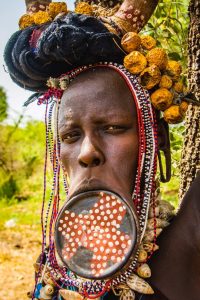
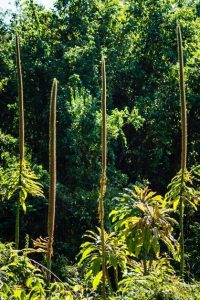
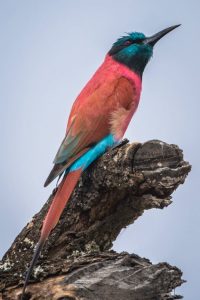

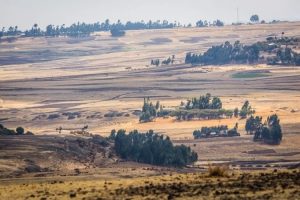
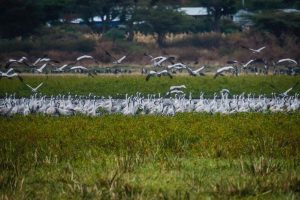
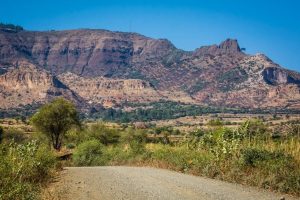
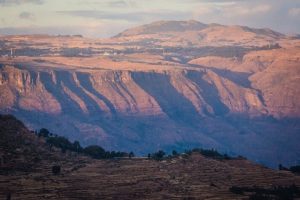

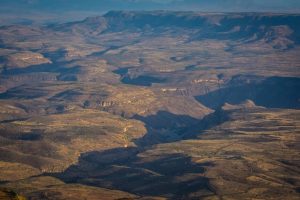

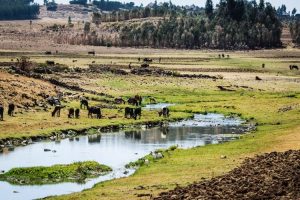
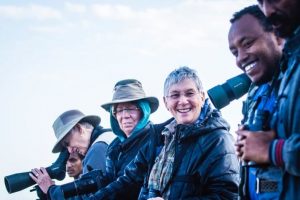

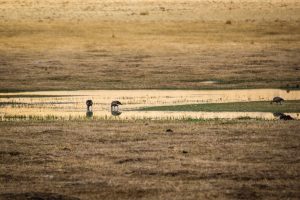
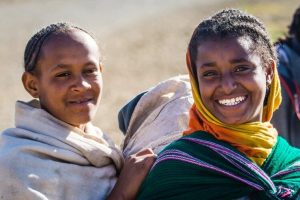
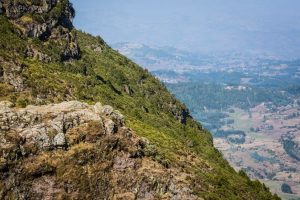
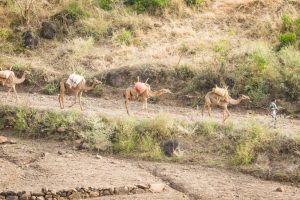
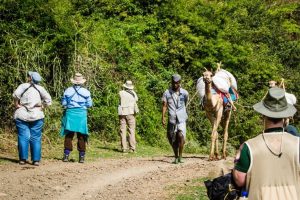
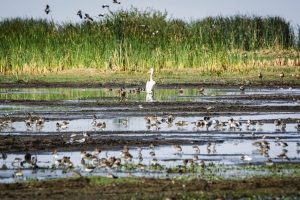
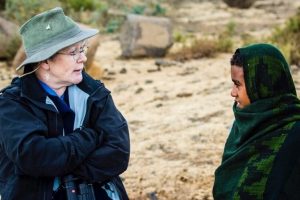
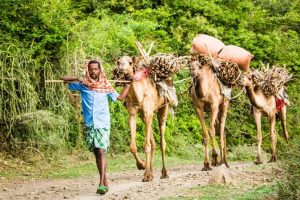

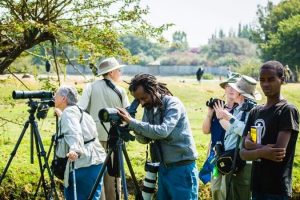
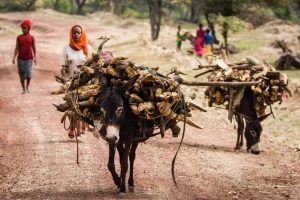
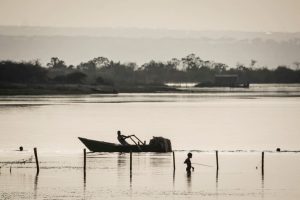
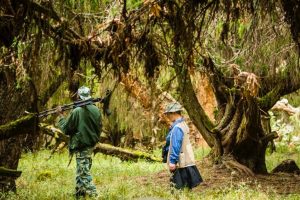
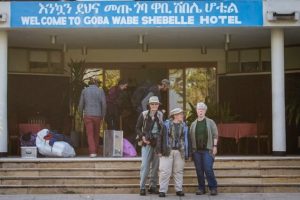
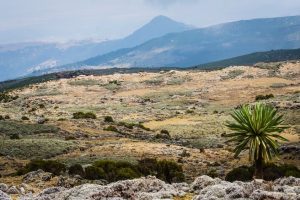
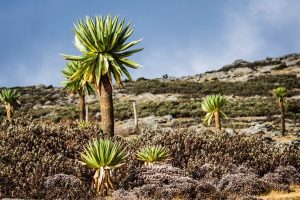

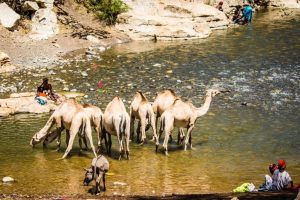


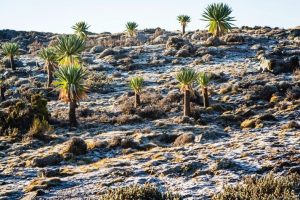
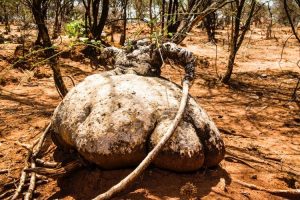
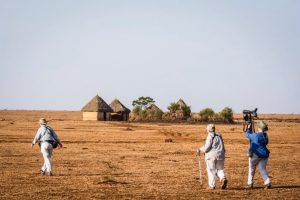
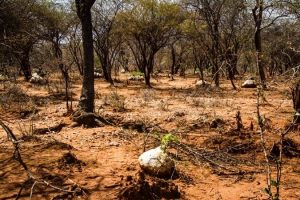

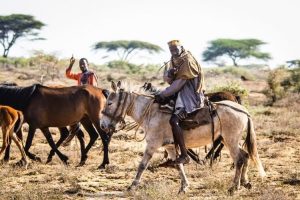

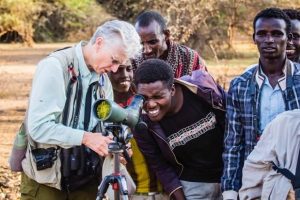
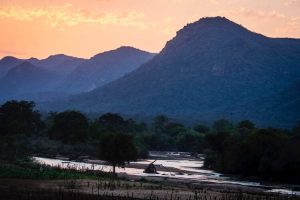
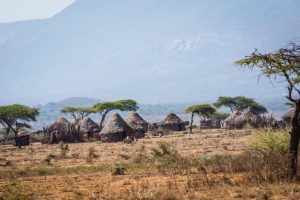
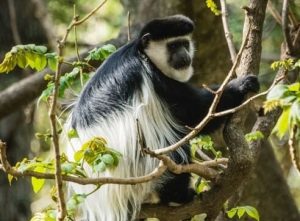
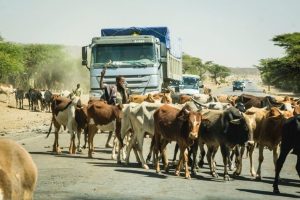
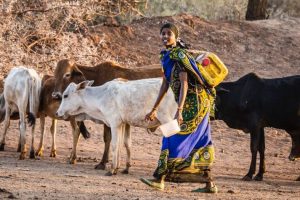
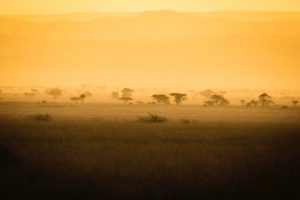

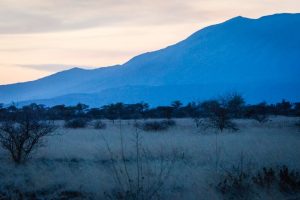
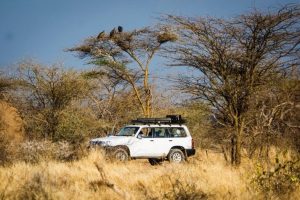
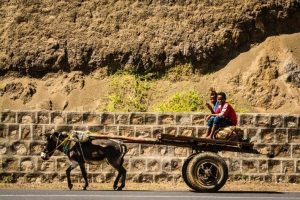



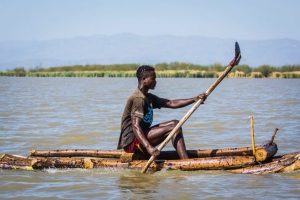
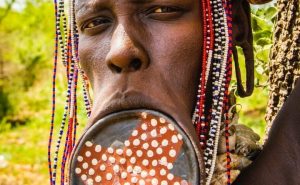

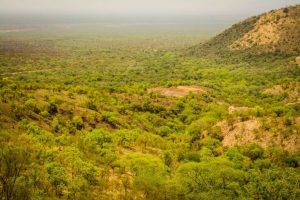
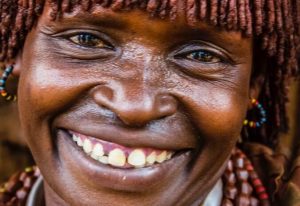
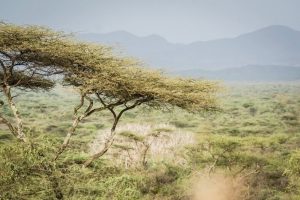
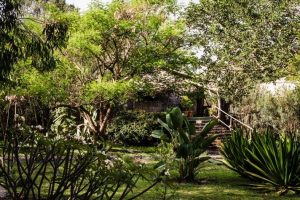
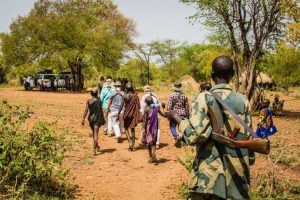

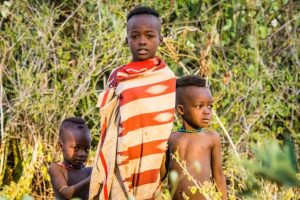
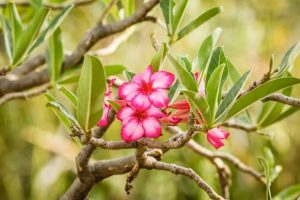
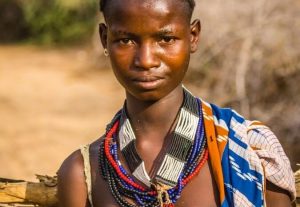
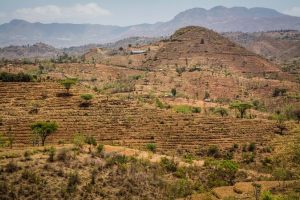
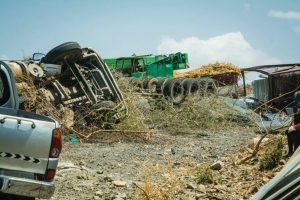
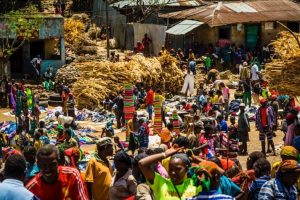
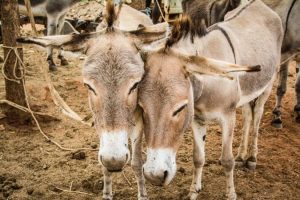
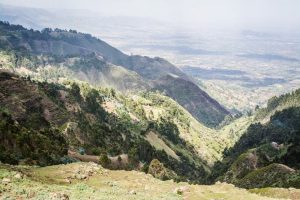
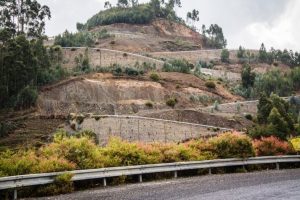
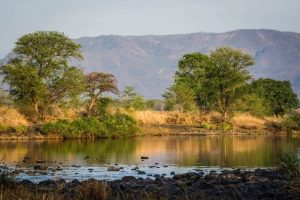
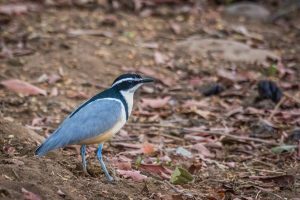






You must be logged in to post a comment.